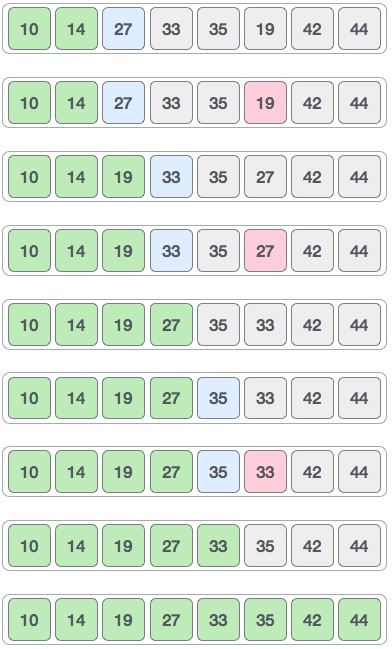Selection sort is a simple sorting algorithm. This sorting algorithm
is an in-place comparison-based algorithm in which the list is divided
into two parts, the sorted part at the left end and the unsorted part at
the right end. Initially, the sorted part is empty and the unsorted
part is the entire list.
The smallest element is selected from the unsorted array and swapped with the leftmost element, and that element becomes a part of the sorted array. This process continues moving unsorted array boundary by one element to the right.
This algorithm is not suitable for large data sets as its average and worst case complexities are of Ο(n2), where n is the number of items.
 For the first position in the sorted list, the whole list is scanned
sequentially. The first position where 14 is stored presently, we search
the whole list and find that 10 is the lowest value.
For the first position in the sorted list, the whole list is scanned
sequentially. The first position where 14 is stored presently, we search
the whole list and find that 10 is the lowest value.
 So we replace 14 with 10. After one iteration 10, which happens to be
the minimum value in the list, appears in the first position of the
sorted list.
So we replace 14 with 10. After one iteration 10, which happens to be
the minimum value in the list, appears in the first position of the
sorted list.
 For the second position, where 33 is residing, we start scanning the rest of the list in a linear manner.
For the second position, where 33 is residing, we start scanning the rest of the list in a linear manner.
 We find that 14 is the second lowest value in the list and it should appear at the second place. We swap these values.
We find that 14 is the second lowest value in the list and it should appear at the second place. We swap these values.
 After two iterations, two least values are positioned at the beginning in a sorted manner.
After two iterations, two least values are positioned at the beginning in a sorted manner.
 The same process is applied to the rest of the items in the array.
The same process is applied to the rest of the items in the array.
Following is a pictorial depiction of the entire sorting process −
 Now, let us learn some programming aspects of selection sort.
Now, let us learn some programming aspects of selection sort.
The smallest element is selected from the unsorted array and swapped with the leftmost element, and that element becomes a part of the sorted array. This process continues moving unsorted array boundary by one element to the right.
This algorithm is not suitable for large data sets as its average and worst case complexities are of Ο(n2), where n is the number of items.
How Selection Sort Works?
Consider the following depicted array as an example. For the first position in the sorted list, the whole list is scanned
sequentially. The first position where 14 is stored presently, we search
the whole list and find that 10 is the lowest value.
For the first position in the sorted list, the whole list is scanned
sequentially. The first position where 14 is stored presently, we search
the whole list and find that 10 is the lowest value. So we replace 14 with 10. After one iteration 10, which happens to be
the minimum value in the list, appears in the first position of the
sorted list.
So we replace 14 with 10. After one iteration 10, which happens to be
the minimum value in the list, appears in the first position of the
sorted list. For the second position, where 33 is residing, we start scanning the rest of the list in a linear manner.
For the second position, where 33 is residing, we start scanning the rest of the list in a linear manner. We find that 14 is the second lowest value in the list and it should appear at the second place. We swap these values.
We find that 14 is the second lowest value in the list and it should appear at the second place. We swap these values. After two iterations, two least values are positioned at the beginning in a sorted manner.
After two iterations, two least values are positioned at the beginning in a sorted manner. The same process is applied to the rest of the items in the array.
The same process is applied to the rest of the items in the array.Following is a pictorial depiction of the entire sorting process −
 Now, let us learn some programming aspects of selection sort.
Now, let us learn some programming aspects of selection sort.Algorithm
Step 1 − Set MIN to location 0 Step 2 − Search the minimum element in the list Step 3 − Swap with value at location MIN Step 4 − Increment MIN to point to next element Step 5 − Repeat until list is sorted
Pseudocode
procedure selection sort list : array of items n : size of list for i = 1 to n - 1 /* set current element as minimum*/ min = i /* check the element to be minimum */ for j = i+1 to n if list[j] < list[min] then min = j; end if end for /* swap the minimum element with the current element*/ if indexMin != i then swap list[min] and list[i] end if end for end procedureTo know about selection sort implementation in C programming language, please click here.

No comments:
Post a Comment